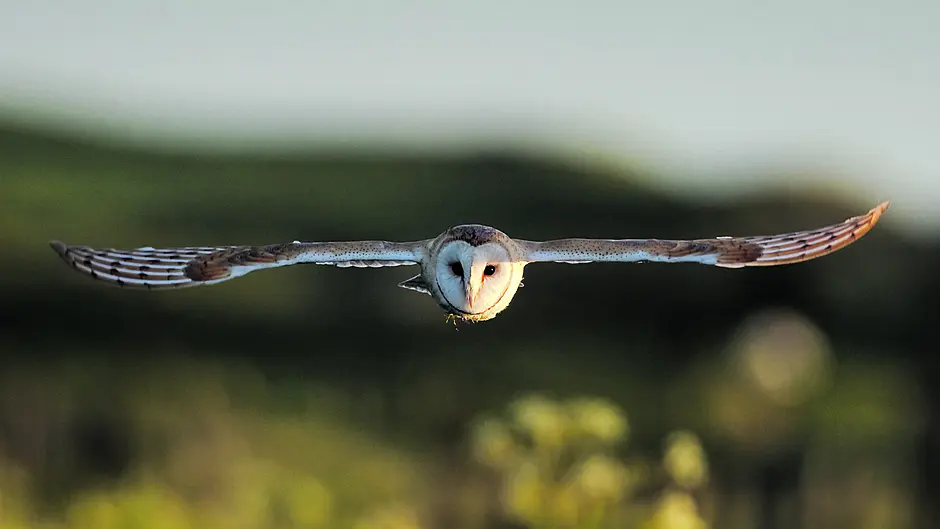BY ANN HAIGH
Watching the Late Late Toy Show this year, we took note of the portrayal of several owls on some artwork that the young guests of the show had produced. Of course, the barn owl (Tyto alba) has long been associated, and is almost synonymous with The Late Late Show.
This got us thinking about owls in our local countryside. Last month, local resident Julie Williams shared some wonderful photos of a short-eared owl (Asio flammeus) that she had seen along the Ilen estuary. This prompted me to write this article and to reach out to Dr Alan McCarthy, BirdWatch Ireland barn owl research officer, for more information about status of owls in our region. Even though we might not get the privilege of seeing owls very often, it is still important to learn more about these beautiful birds.
Visiting short-eared owls
Despite there being over 200 species of owl globally, only three species are relevant in Ireland. The iconic barn owl and the long-eared owl (Asio otus) are our two resident species, and the short-eared owl, as seen recently along the Ilen, is a scarce winter visitor. Short-eared owls breed in Scandinavia, Russia, Iceland, northern parts of the UK and occasionally in very small numbers in Ireland. Principally, it is winter that affords us the possibility of seeing them because they travel southwards to escape the harsher conditions further north.
It seems that 2023 has already been an outstanding year for spotting them in Ireland. According to Dr McCarthy: ‘This autumn we have experienced an incredible influx of short-eared owls into Ireland. During a typical autumn and winter, we might expect to hear of short-eared owl sightings scattered along the coast, mostly seen in singles or sometimes two. This autumn is different though, with multiple reports of four or more birds seen together, including in East Cork, with single birds being reported all along the coast and in some inland areas too.
‘The reasons behind this massive influx are not clear yet. It may be the result of a very productive breeding season in their more northerly breeding grounds, and weather conditions may be partly responsible too.’
Short-eared owls are unusual because they are the only owl species that habitually hunt during the day in Ireland, so do keep your eyes open.
Resident long-eared owls
The long-eared owl is our most common resident owl and is found widely across Ireland. That said, they are rarely seen because they are nocturnal and elusive. Often, we are only alerted to their presence when they have young, because the chicks call repeatedly for food throughout the night when the adults are out hunting.
The begging call of the chicks is often described as the ‘squeaky gate’ call, as that is exactly what it sounds like. On a calm summer’s night, the ‘squeaky gate’ call of a young long-eared owl can be heard from nearly a kilometre away. They are most often associated with coniferous woodland, where they can roost and nest, and that has open grassland nearby, where they can
hunt.
Their two ear-like tufts, from which they get their name, are distinctive but are not their ears. They are a display of long feathers which become erect when they are alarmed, or alert, and lie flat when relaxed, or in flight.
Barn owls
The sight of a barn owl hunting at night, a white ghost-like shape in the dark night, is truly spell-binding. It is not quite clear why barn owls are so white underneath. Many say it is an ‘anti-silhouette’ strategy, making them less obvious as a dark outline when viewed from below. An association with moonlight has also been studied.
Barn owls have a small body relative to their wing size and this gives them the ability to fly very slowly, as slow as two miles per hour. This gives them plenty of time to locate their prey below. Barn owls have also been called ‘screech owls’ because they use a loud screech as part of their breeding and territorial behaviour.
The diet of barn owls in Ireland primarily consists of small mammals such as mice, rats, voles, and shrews. Very occasionally other prey such as birds or amphibians may be taken. Like other owl species, barn owls eat their prey whole but need to regurgitate what they cannot digest, such as fur, teeth and bones, in the form of a pellet.
Finding pellets is great evidence for the presence of owls. A barn owl will typically eat three to four prey items a night and during the breeding season, each owlet will require the same. The average brood size is three. It is estimated that 4,000 prey animals are required per year to feed a breeding pair and their offspring. It is this aspect which gives the barn owl their reputation as the ‘farmers’ friend’ for the role they play in managing rodent populations.
Owls under pressure
Sadly, barn owl populations declined drastically in the 20th century due to the intensification of agriculture, which reduced roosting and nesting habitat and the numbers of prey species. Habitat loss, including the removal of hedgerows and rough grassland, is still an ongoing threat, along with road traffic collisions and the use of anti-coagulant rodenticides. Owls suffer secondary poisoning via the consumption of poisoned rodents and research has detected the presence of poisons in at least 85% of Irish barn owls. Barn owl populations have decreased by around 40% over the past 50 years and this has prompted them to be classified as a red-listed species of conservation concern in Ireland.
Monitoring barn owls
However, there is some positive news. The south-west of Ireland has for some time been identified as a stronghold for the barn owl and recent findings show this is still the case. At the end of summer, as part of the 2023 barn owl survey, run by BirdWatch Ireland and supported by Cork County Council and the National Parks and Wildlife service through the National Biodiversity Action Plan, Dr McCarthy reported that 114 barn owl nests were recorded in Co. Cork. He advised that ‘this represents a breeding range increase of 132% over the last 10 years.’ Dr McCarthy also commented that although the core population is in the east and north of the county, that ‘West Cork has its fair share of barn owls too, with 16 nests found in the region’ and that more are likely to be discovered.
A helping hand
Dr McCarthy also explained that the reasons behind the recent increase in barn owl numbers across the county is complex. He advised that a changing small mammal community, through the spread of the invasive greater white-toothed shrew, and the provision of barn owl nest boxes are playing key roles in the increase. The most common nest site type recorded in 2023 in the county was nest boxes, with 46 breeding pairs recorded using boxes.
To provide this helping hand, grants are available to farmers for barn owl nest boxes through the ACRES scheme. However, it is best to consult with BirdWatch Ireland on their location and design. Inappropriately designed and placed nest boxes may cause owl fatalities. More information may be obtained by contacting Dr McCarthy at Birdwatch Ireland at [email protected].
Sightings of barn owls (both live and dead), potential nest sites, and nest boxes installed by landowners can be reported via BirdWatch Ireland: https://bit.ly/barnowl-survey.









